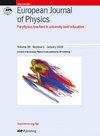Exploring mass–energy equivalence with consideration of quantum nature
IF 0.8
4区 教育学
Q4 EDUCATION, SCIENTIFIC DISCIPLINES
引用次数: 0
Abstract
Mass–energy equivalence (MEE) has become a basis of modern physics. In spite of the current educational trends highlighting modern physics education, it has been pointed out that interpretations of MEE are still not in general agreement. In addition, the derivations of MEE found in textbooks gloss over some logical oversights. MEE is often introduced with only a declarative knowledge that mc 2 represents the rest energy of a particle, making the learning process difficult for students. To resolve the instructional challenges, distinguished papers on MEE are analyzed. By specifying common features of derivations in each paper, it is found that there are at least three types of MEE. By identifying the entire hierarchical structure of each one, a type of MEE is suggested that can potentially be useful in the establishment of the connection between the particle and field.考虑量子性质探索质能等价
质能等效已经成为现代物理学的基础。尽管当前的教育趋势突出了现代物理教育,但有人指出,对MEE的解释仍然不一致。此外,教科书中对MEE的推导掩盖了一些逻辑上的疏漏。MEE通常只引入一个声明性知识,即MC2代表粒子的剩余能量,这使得学生的学习过程变得困难。为了解决教学上的挑战,分析了有关MEE的著名论文。通过在每篇论文中指定派生词的共同特征,发现至少有三种类型的MEE。通过识别每个粒子的整个层次结构,提出了一种可能有助于建立粒子和场之间联系的MEE类型。
本文章由计算机程序翻译,如有差异,请以英文原文为准。
求助全文
约1分钟内获得全文
求助全文
来源期刊

European Journal of Physics
物理-物理:综合
CiteScore
1.70
自引率
28.60%
发文量
128
审稿时长
3-8 weeks
期刊介绍:
European Journal of Physics is a journal of the European Physical Society and its primary mission is to assist in maintaining and improving the standard of taught physics in universities and other institutes of higher education.
Authors submitting articles must indicate the usefulness of their material to physics education and make clear the level of readership (undergraduate or graduate) for which the article is intended. Submissions that omit this information or which, in the publisher''s opinion, do not contribute to the above mission will not be considered for publication.
To this end, we welcome articles that provide original insights and aim to enhance learning in one or more areas of physics. They should normally include at least one of the following:
Explanations of how contemporary research can inform the understanding of physics at university level: for example, a survey of a research field at a level accessible to students, explaining how it illustrates some general principles.
Original insights into the derivation of results. These should be of some general interest, consisting of more than corrections to textbooks.
Descriptions of novel laboratory exercises illustrating new techniques of general interest. Those based on relatively inexpensive equipment are especially welcome.
Articles of a scholarly or reflective nature that are aimed to be of interest to, and at a level appropriate for, physics students or recent graduates.
Descriptions of successful and original student projects, experimental, theoretical or computational.
Discussions of the history, philosophy and epistemology of physics, at a level accessible to physics students and teachers.
Reports of new developments in physics curricula and the techniques for teaching physics.
Physics Education Research reports: articles that provide original experimental and/or theoretical research contributions that directly relate to the teaching and learning of university-level physics.
 求助内容:
求助内容: 应助结果提醒方式:
应助结果提醒方式:


